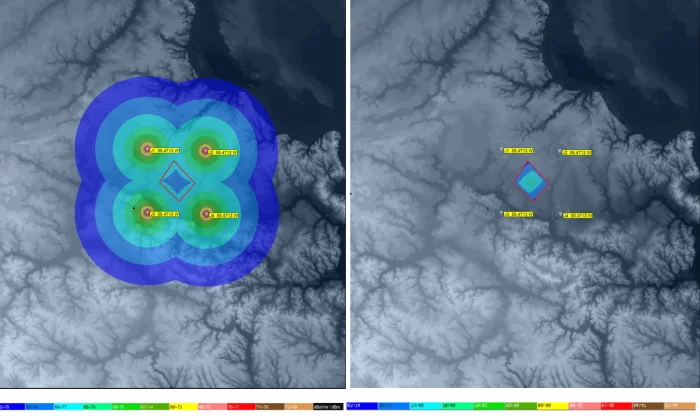Use HTZ Warfare to design GNSS and CRPA jamming maps
The emergence of CRPA drones to counter jamming measures through beamforming has been a game changer.
Find out HTZ Warfare designs Counter UAV systems taking this into account.
Details
More Products & Services
Products & Services
HTZ Web API
ATDI South Pacific Pty Ltd
Web APIs play a pivotal role in integrating diverse systems allowing different applications to collaborate seamlessly across the web. By automating complex tasks the complexity of network deployments is removed. HTZ Web API embraces RESTful API principles and leverages standard HTTP methods, recognised for their simplicity and scalability. It supports JSON and XML formats to structure data, ensuring the API responses are lightweight and easily readable.
HTZ integrates seamlessly into third-party solutions, working as a backend spectrum engine. By adding a customised user interface, the end user can request and receive data via the API and support task automation. Requests are combined to fulfil end-user requirements or specific use scenarios.
The Web API functionality enables real-time network insights by sharing dynamic and up-to-the-minute data for informed decision-making. The API transmits real-time information like power consumption and station status through the network monitoring system. This data is then used to visualise its impact on coverage, overlay reference signals, and assess the received radio signal strength (RSSI) in specific regions. Additional information encompasses optimal server information, overlap areas, and the number of received channels. The collaborative sharing of this data ensures the adaptive reallocation of the network, acting as a security measure to protect sensitive systems and information in secure locations.
Benefits
Enhanced Accuracy: the API shared cartographic engine minimises errors, ensuring precise calculations for terrain and positioning data.
Advanced Modelling: supports complex 3D terrain and propagation analysis, delivering reliable results across various applications.
Customisable: Offers extensive custom functions to tailor solutions for specific project needs and to integrate diverse data sources.
High Performance: efficiently handles large-scale calculations, making it ideal for demanding projects.
Secure: provides robust data security and privacy in a secure environment, essential for sensitive information.
Versatile: supports every radiocommunication applications from terrestrial to satellite communications.
HTZ integrates seamlessly into third-party solutions, working as a backend spectrum engine. By adding a customised user interface, the end user can request and receive data via the API and support task automation. Requests are combined to fulfil end-user requirements or specific use scenarios.
The Web API functionality enables real-time network insights by sharing dynamic and up-to-the-minute data for informed decision-making. The API transmits real-time information like power consumption and station status through the network monitoring system. This data is then used to visualise its impact on coverage, overlay reference signals, and assess the received radio signal strength (RSSI) in specific regions. Additional information encompasses optimal server information, overlap areas, and the number of received channels. The collaborative sharing of this data ensures the adaptive reallocation of the network, acting as a security measure to protect sensitive systems and information in secure locations.
Benefits
Enhanced Accuracy: the API shared cartographic engine minimises errors, ensuring precise calculations for terrain and positioning data.
Advanced Modelling: supports complex 3D terrain and propagation analysis, delivering reliable results across various applications.
Customisable: Offers extensive custom functions to tailor solutions for specific project needs and to integrate diverse data sources.
High Performance: efficiently handles large-scale calculations, making it ideal for demanding projects.
Secure: provides robust data security and privacy in a secure environment, essential for sensitive information.
Versatile: supports every radiocommunication applications from terrestrial to satellite communications.
HTZ Warfare
ATDI South Pacific Pty Ltd
The only RF simulation software, focused exclusively on military and defence communication networks. For Army, Air Force and Navy.
Covering all military communications from VHF/UHF, HF, ground to ground, ground to air comms, every wireless technology from kHz to THz.
Complete electronic warfare simulations through radar coverage, direction finder optimization, jamming coverage and efficiency, on the move jamming, CRPA drone jamming, counter drone/UAV network planning, flight path analysis, MANET networks, etc.
With HTZ Warfare, you can simulate any electronic warfare environment for tactical mission planning, offensive or defensive electromagnetic spectrum operations.
Boasting a massive library of almost 50 radio propagation models and global cartographic data for immediate, out-of-the-box RF simulations.
Powerful, comprehensive, and complete!
Covering all military communications from VHF/UHF, HF, ground to ground, ground to air comms, every wireless technology from kHz to THz.
Complete electronic warfare simulations through radar coverage, direction finder optimization, jamming coverage and efficiency, on the move jamming, CRPA drone jamming, counter drone/UAV network planning, flight path analysis, MANET networks, etc.
With HTZ Warfare, you can simulate any electronic warfare environment for tactical mission planning, offensive or defensive electromagnetic spectrum operations.
Boasting a massive library of almost 50 radio propagation models and global cartographic data for immediate, out-of-the-box RF simulations.
Powerful, comprehensive, and complete!
ICS Monitoring SDRN Control
ATDI South Pacific Pty Ltd
ICS Monitoring is a flexible network monitoring solution that allows users to better understand the impact of interference on their network and others. It is compatible with leading hardware monitoring equipment suppliers and allows the user to work with different hardware suppliers simultaneously. ICS Monitoring manages a variety of measurement data and features an automatic post-processing function for real-time data streams. It forms part of our spectrum management solution and is fully compatible with ICS Manager.
ICS Monitoring can be used to assess spectrum use, monitor emissions and regulate the control of license emissions. It performs tasks in accordance with radio license regulations and verifies compliance with the frequency allocation conditions, frequency use and channel occupancy. ICS Monitoring can be used to generate interference case studies and search for unauthorised emissions.
ICS Monitoring can be used to assess spectrum use, monitor emissions and regulate the control of license emissions. It performs tasks in accordance with radio license regulations and verifies compliance with the frequency allocation conditions, frequency use and channel occupancy. ICS Monitoring can be used to generate interference case studies and search for unauthorised emissions.
Description
Controlled Radiation Pattern Antennas (CRPAs) are the latest evolution to counter anti-GNSS jamming by cancelling out signals through beamforming. ATDI's HTZ Warfare features a “GNSS -CRPA Jamming map” function that allows users to plan jamming deployments to counter enemy tactics, as well ensuring uninterrupted GPS reception by estimating the enemy’s GPS jamming capacity.
To ensure effective jamming, more jammers are required than antenna elements in the CRPA. For example, jamming a four-element antenna requires at least four jammers. Those coverage outputs are applied to a given area needing protection by using a vector polygon, allowing the user to determine and modify the area to consider.
The GNSS receiver configuration manages the number of elements including null and beam steering, spacing, antenna beamwidth, antenna gain and beamforming thresholds. It also incorporates parameters like GPS frequency, antenna height and jamming thresholds. Jammer settings include the maximum distance from each jammer to limit calculations, an option to consider composite coverage or to use existing calculations, and the ability to determine which jamming signals to reject.
Once configured, the software calculates the jammer's effective coverage area against the specific threat defined. HTZ uses two methods to apply these calculations:
Method 1 considers CRPA jamming by acknowledging challenges with dynamically generating radiation patterns. This suits Fixed Radiation Pattern Antennas (FRPAs) or CRPAs, for which NULL steering is automatically configured, depending on the strongest jamming signal exceeding the defined threshold.
Method 2 enables users to customise the CRPA's jamming resistance. To define the beam suppression for Null steering, the "statistic values" button can be used to assign rejection values to elements based on their spatial placement from the main jamming signal. These values are applied to each Null' Beam suppression. Users can also define this in their data. The outputs from both methods illustrate where each mapped point is jammed, rendering a CRPA receiver unable to receive a GNSS signal. The images shown below display the composite jammer coverage and CRPA effective coverage.
GNSS - CRPA Jamming map: CRPA Jamming stands for GPS jamming performed on any GPS receiver, including Fixed and Controlled Radiation Pattern Antennas (FRPA and CRPA). Jamming involves emitting radio frequency signals on the same frequencies as those used by the guidance systems of the munitions, thereby interfering with their ability to receive accurate positioning information. This interference can cause the munitions to miss their intended targets or become ineffective. CPRA jamming has proven to be an effective electronic warfare tactic used to counter the effectiveness of precision-guided munitions on the battlefield.
To ensure effective jamming, more jammers are required than antenna elements in the CRPA. For example, jamming a four-element antenna requires at least four jammers. Those coverage outputs are applied to a given area needing protection by using a vector polygon, allowing the user to determine and modify the area to consider.
The GNSS receiver configuration manages the number of elements including null and beam steering, spacing, antenna beamwidth, antenna gain and beamforming thresholds. It also incorporates parameters like GPS frequency, antenna height and jamming thresholds. Jammer settings include the maximum distance from each jammer to limit calculations, an option to consider composite coverage or to use existing calculations, and the ability to determine which jamming signals to reject.
Once configured, the software calculates the jammer's effective coverage area against the specific threat defined. HTZ uses two methods to apply these calculations:
Method 1 considers CRPA jamming by acknowledging challenges with dynamically generating radiation patterns. This suits Fixed Radiation Pattern Antennas (FRPAs) or CRPAs, for which NULL steering is automatically configured, depending on the strongest jamming signal exceeding the defined threshold.
Method 2 enables users to customise the CRPA's jamming resistance. To define the beam suppression for Null steering, the "statistic values" button can be used to assign rejection values to elements based on their spatial placement from the main jamming signal. These values are applied to each Null' Beam suppression. Users can also define this in their data. The outputs from both methods illustrate where each mapped point is jammed, rendering a CRPA receiver unable to receive a GNSS signal. The images shown below display the composite jammer coverage and CRPA effective coverage.
GNSS - CRPA Jamming map: CRPA Jamming stands for GPS jamming performed on any GPS receiver, including Fixed and Controlled Radiation Pattern Antennas (FRPA and CRPA). Jamming involves emitting radio frequency signals on the same frequencies as those used by the guidance systems of the munitions, thereby interfering with their ability to receive accurate positioning information. This interference can cause the munitions to miss their intended targets or become ineffective. CPRA jamming has proven to be an effective electronic warfare tactic used to counter the effectiveness of precision-guided munitions on the battlefield.

Share
Recent Chats
Share via email
Future: handle WhatsApp here
Future: handle LinkedIn here
Future: handle Twitter here
SUBMENU HERE
Share via Chat
Copy Link


